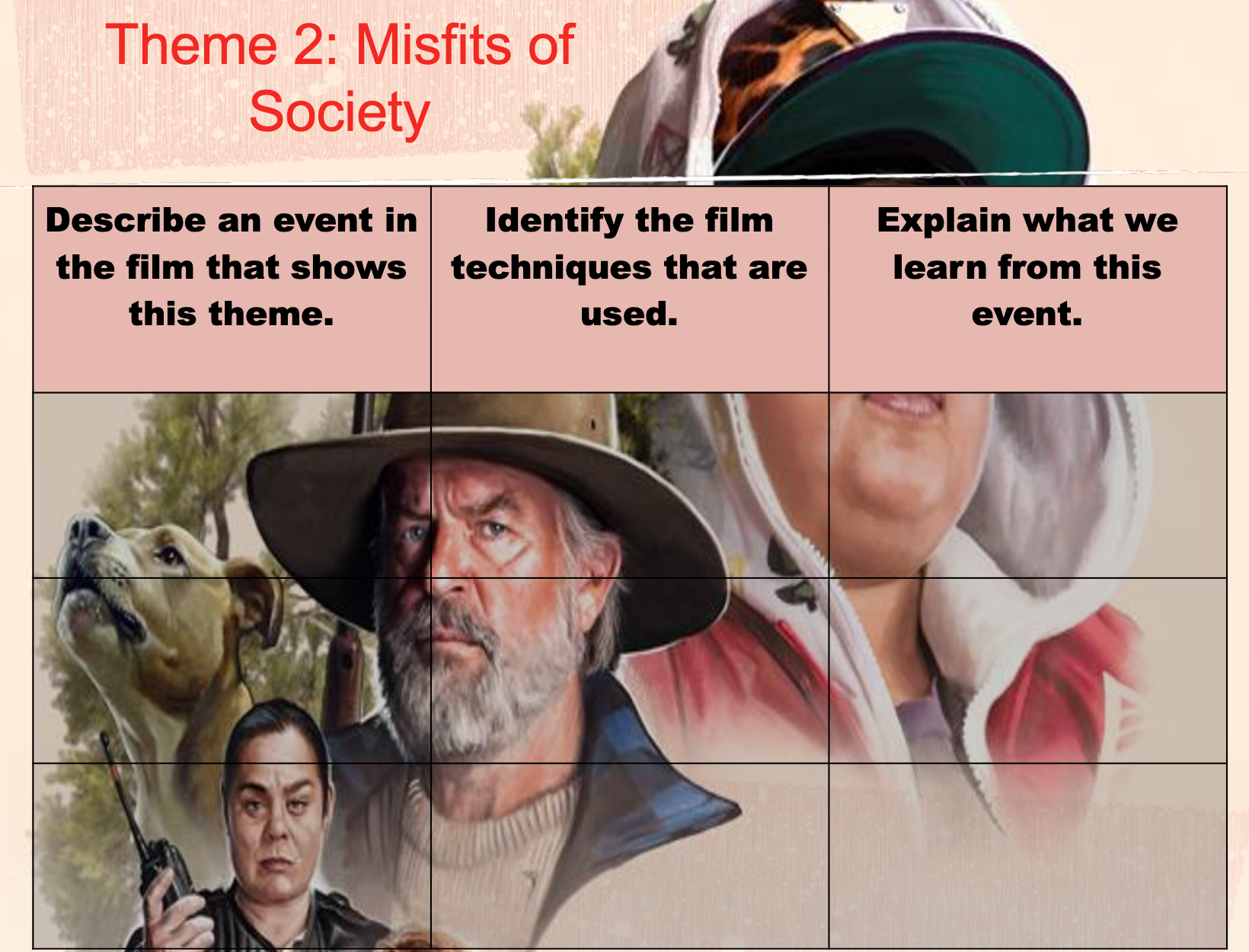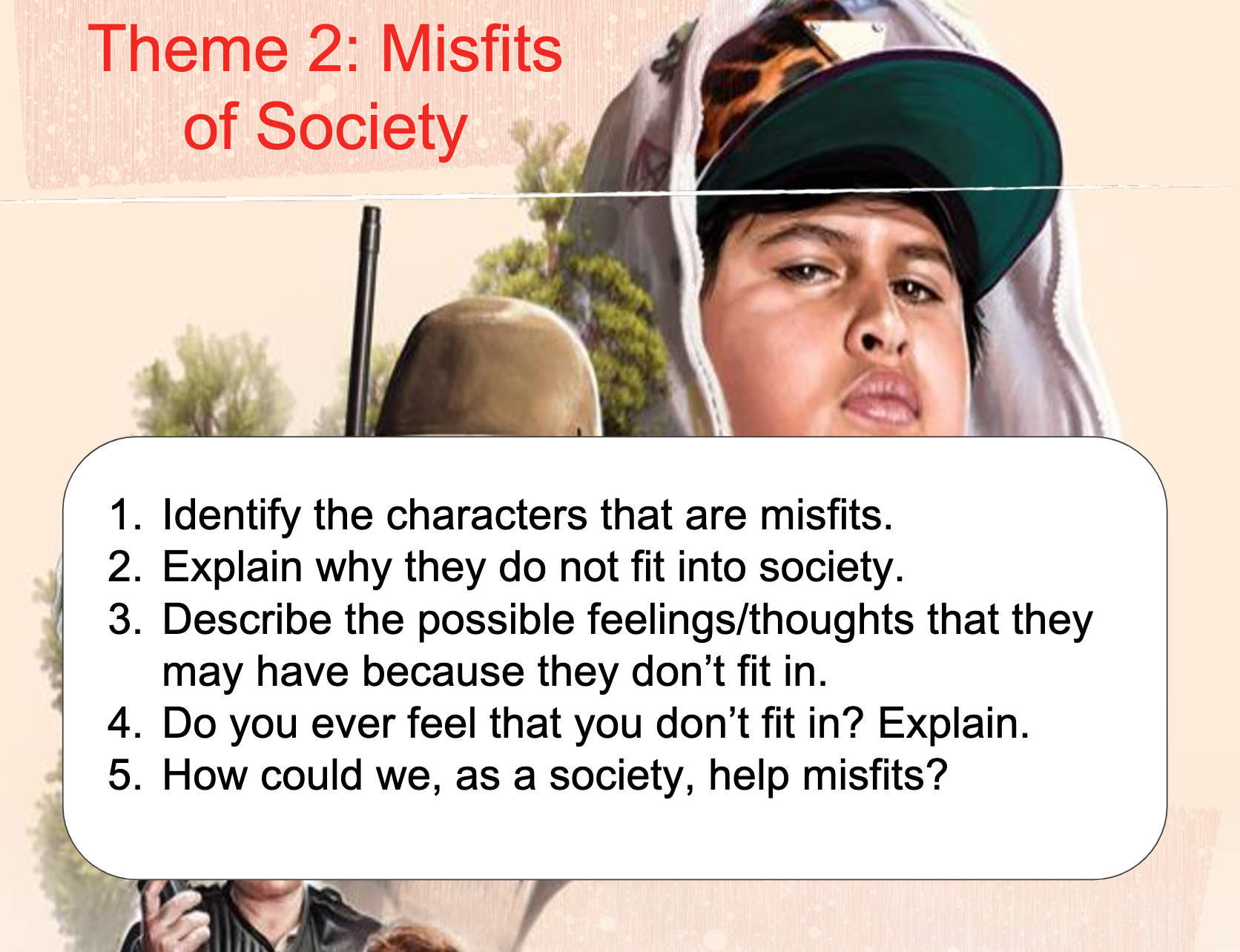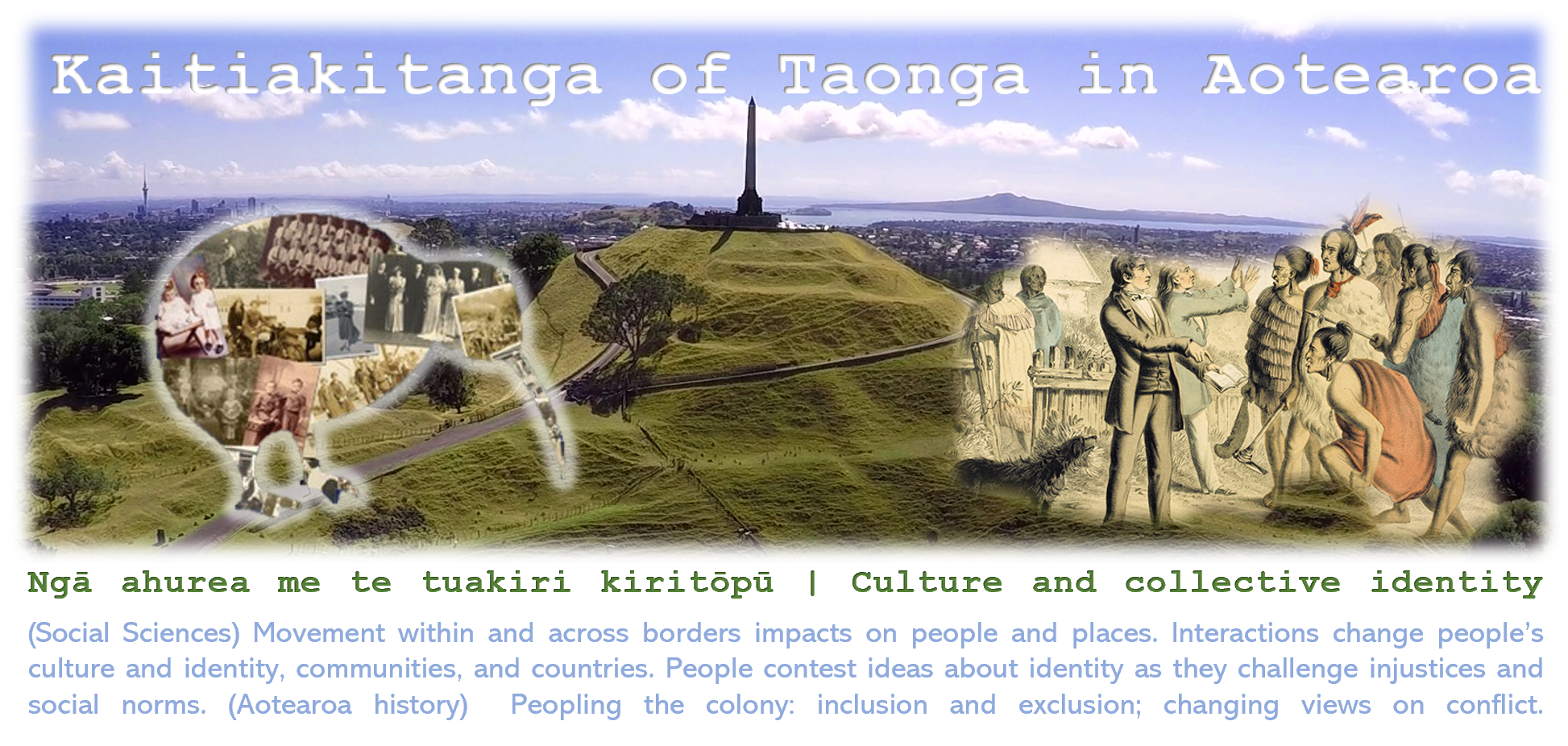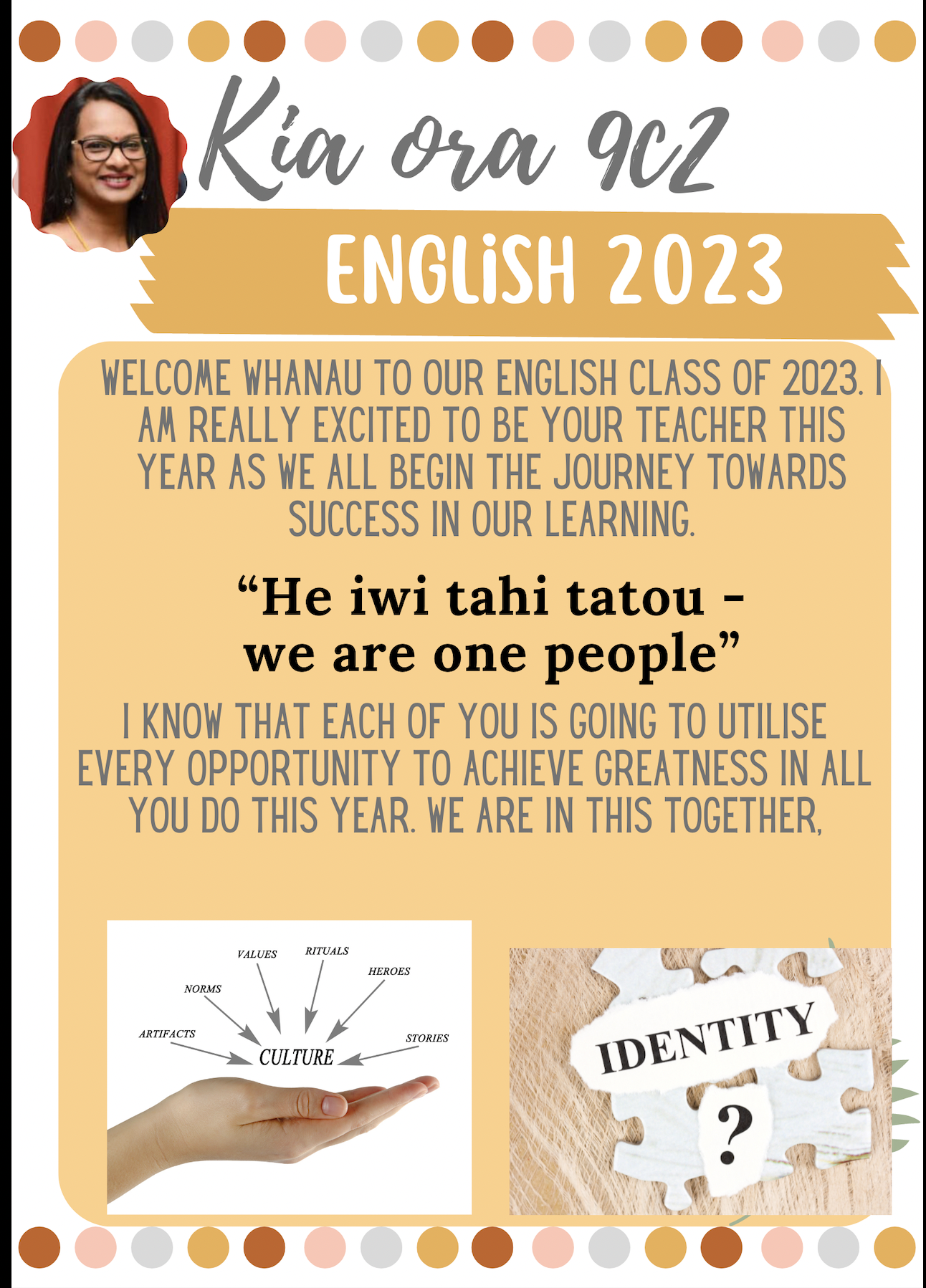9C2 English
Section outline
-
Nau mai, haere mai - Welcome to the start of an exciting new term.
We have much to do to prepare ourselves for this learning journey. I hope you all had a great rest and are ready to tackle this term.FOCUS / ARONGA learning intentions:
- We are FOCUSING on developing our writing for the intended audience.
MHJC GREAT Learner Learning to Learn / Ako: Feedback

I am a learner with innovation skills that will enable me to navigate the 21st century:
- Emerging:
- I think creativity to solve challenges
- I demonstrate the skills to work collaboratively with others
- I have oral, written and non-verbal communication skills
- Growing:
- I work creativity with others to solve challenges
- When working collaboratively, I exercise flexibility and willingness to compromise to achieve a common goal
- I am a clear communicator; oral, written and nonverbal
- Students will be able to identify the intended audience for a piece of writing.
- Students will be able to write in a way that is appropriate for the intended audience.
- Students will be able to use language features to create specific effects on the intended audience.
Success Criteria:
- Students can identify the key characteristics of their intended audience, such as their age, interests, and level of knowledge.
- Students can use a variety of writing techniques, such as tone, style, and register, to tailor their writing to their intended audience.
- Students can use language features, such as specific vocabulary and sentence structures, to create specific effects on their intended audience.
We will be using the CAT practice questions this week- to refine our understanding of writing for a particular audience.
-
PLAN & DO / WHAKAMAHI learning intentions:
- We are PLANNING our writing so that we can use the TEXAS paragraph structure in essay writing.
I am an active learner as I know what I need to learn, where I am with that learning and what my next learning steps are:
- Emerging:
- I know what I am learning and why
- I can use evidence to identify where I am with my learning
- I can use evidence to identify my next learning steps
- Growing:
- I can describe what I am learning and why, using our shared language for learning; GREAT Ako
- I can use evidence to describe where I am with my learning
- I can use evidence to plan and take my next learning steps
MHJC Great Learner Learning to Learn / Ako: Learning and Thinking Strategy
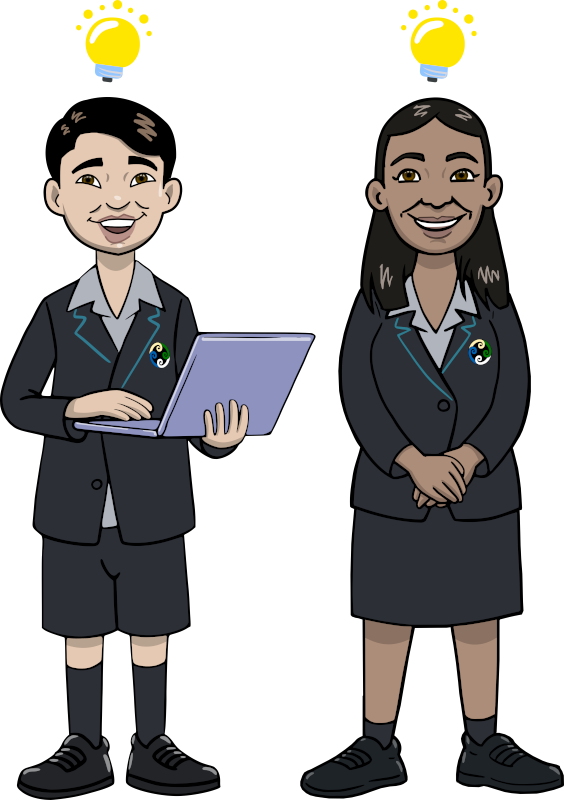
Learning Intention:
Students will be able to write a TEXAS paragraph.
Success Criteria:
- Students can identify the four components of a TEXAS paragraph: Topic, Explanation, eXample, and So What.
- Students can write a clear and concise topic sentence that states their main point.
- Students can provide relevant evidence to support their topic sentence.
- Students can explain how their evidence supports their topic sentence.
- Students can summarise their main point in the So What sentence.
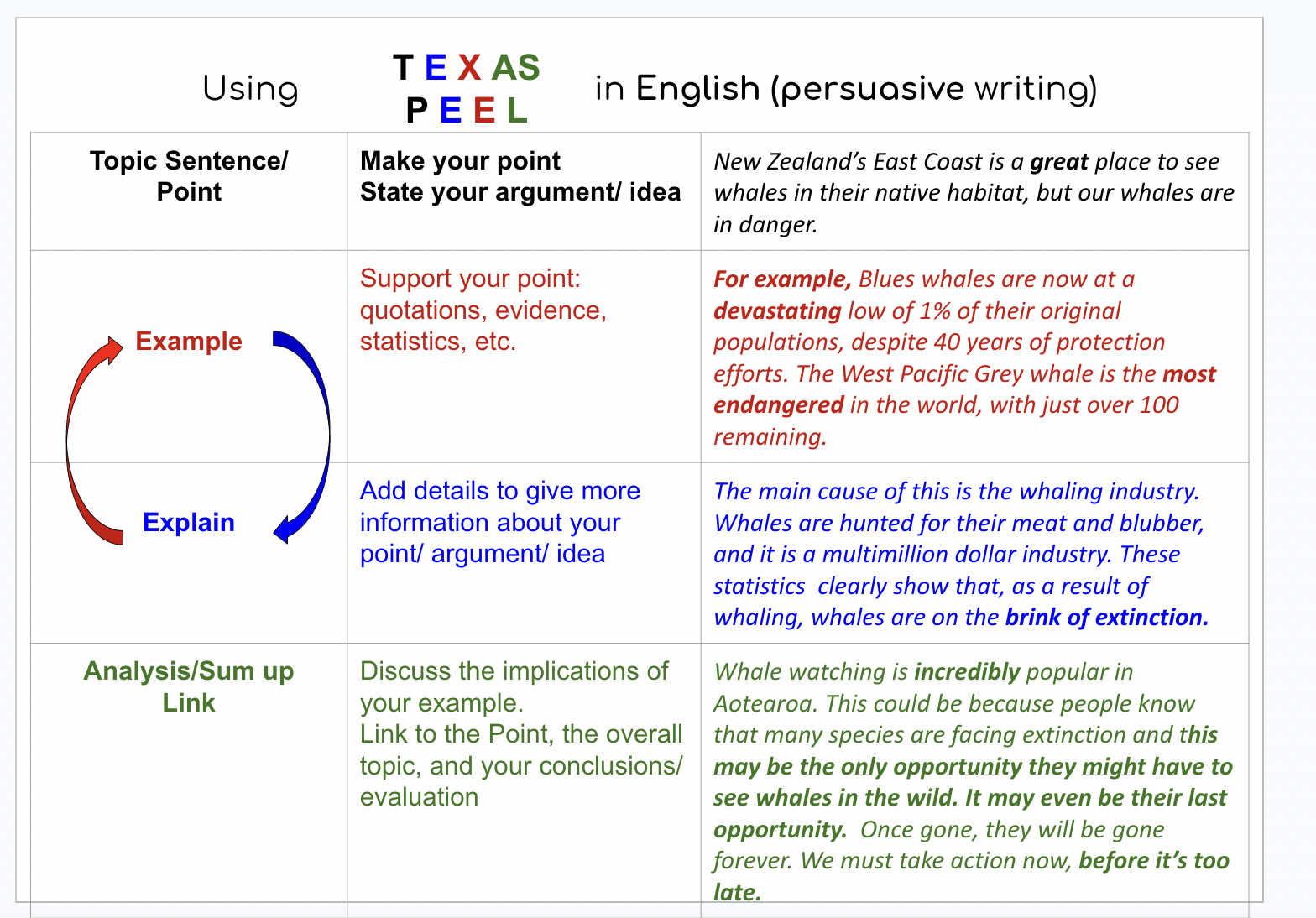
Learning activities- assigned on the GC -
EXPLORE / TŪHURA learning intentions:
- We are EXPLORING the visual language features in a short film.
- We are OBSERVING the camera angles and visual techniques used.
MHJC GREAT Learner Learning to Learn / Ako: Digital Literacy
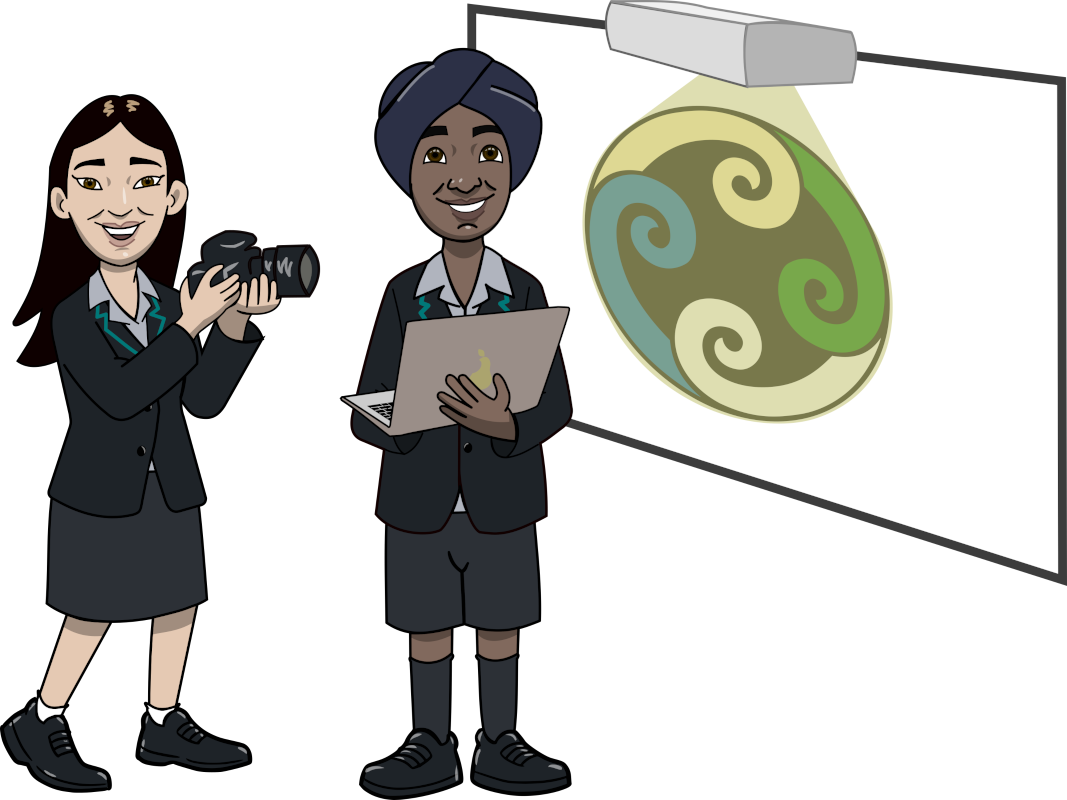
MHJC Great Learner Learning to Learn / Ako: Learning and Thinking Strategy

Learning Intentions:
- Students will be able to analyze and interpret the short film Koro's Medal.
- Students will be able to identify and discuss key themes in the film, such as cultural identity, loss, and memory.
- Students will be able to write a well-organized and insightful critical response to the film.
- Students will be able to analyze and interpret the short film Koro's Medal.
- Students will be able to identify and discuss the use of camera angles and visual techniques in the film.
- Students will be able to explain how camera angles and visual techniques contribute to the meaning of the film.
- Students can identify at least three key themes in the film.
- Students can provide evidence from the film to support their interpretations of these themes.
- Students can write a critical response that is well-organized and insightful.
- Students use appropriate language and grammar in their writing.
- Students can identify at least three different camera angles or visual techniques used in the film.
- Students can explain how the camera angles or visual techniques they have identified contribute to the meaning of the film.
- Students can use appropriate film language in their discussions and writing.
Learning activities: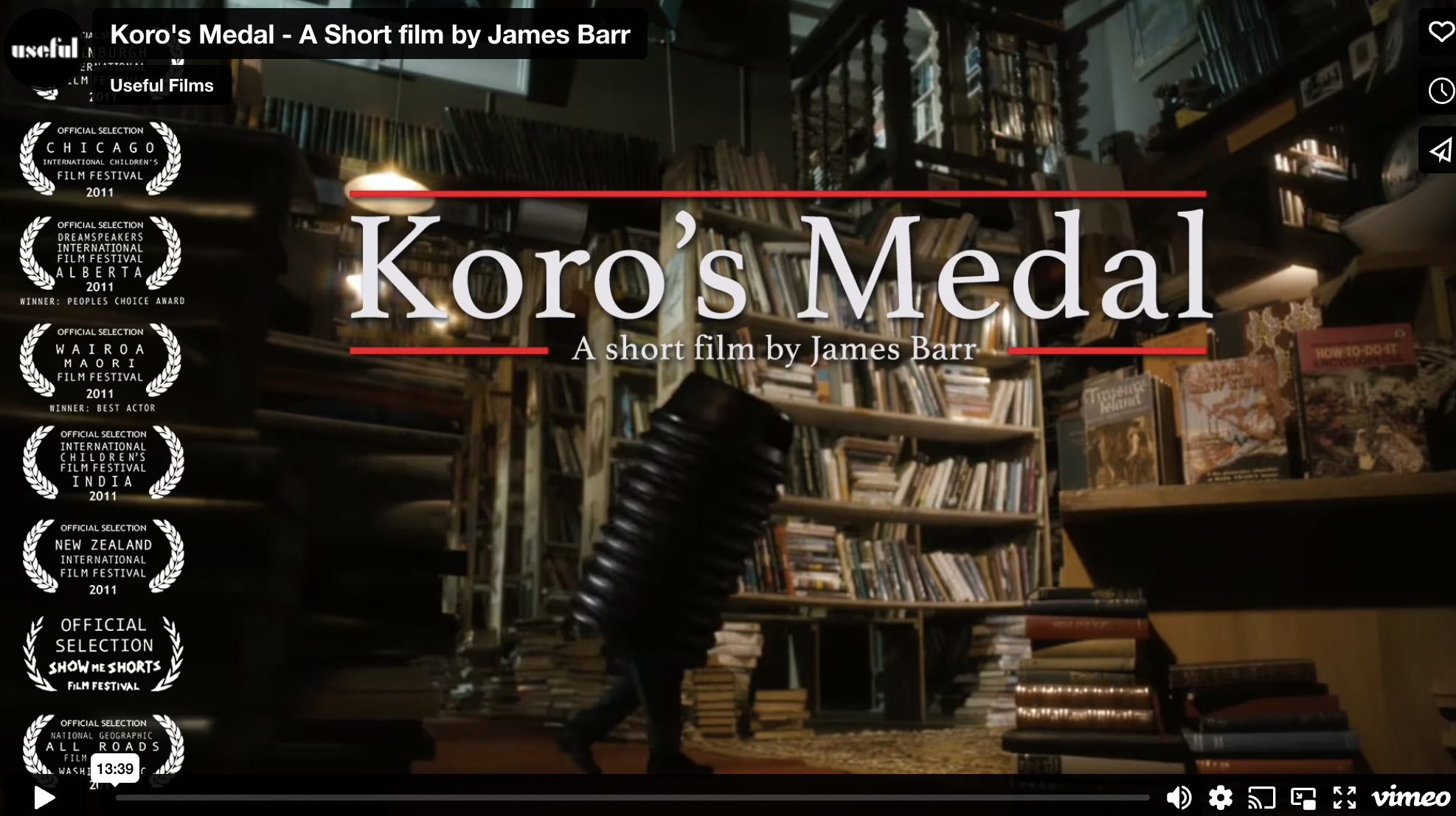
Exploring Characters:
- Why was Billy so desperate to get the medal back when he dropped it?
- What would you have done in that situation?
- How did the filmmaker tell us about the thieves? Were there different ways used to tell us about them?
- Why was Koro so special to the family? What were his special accomplishments?
- What did Billy learn about his family through the film?
- How did the family show that their Koro was still important to them? What did that look like in the film?
-
EXPLORE / TŪHURA learning intentions:
- We are EXPLORING the visual language features in a short film.
- We are OBSERVING the camera angles and visual techniques used.
MHJC GREAT Learner Learning to Learn / Ako: Digital Literacy

MHJC Great Learner Learning to Learn / Ako: Learning and Thinking Strategy

Learning Intentions:
- Students will be able to analyze and interpret the short film Koro's Medal.
- Students will be able to identify and discuss key themes in the film, such as cultural identity, loss, and memory.
- Students will be able to write a well-organized and insightful critical response to the film.
- Students will be able to analyze and interpret the short film Koro's Medal.
- Students will be able to identify and discuss the use of camera angles and visual techniques in the film.
- Students will be able to explain how camera angles and visual techniques contribute to the meaning of the film.
- Students can identify at least three key themes in the film.
- Students can provide evidence from the film to support their interpretations of these themes.
- Students can write a critical response that is well-organized and insightful.
- Students use appropriate language and grammar in their writing.
- Students can identify at least three different camera angles or visual techniques used in the film.
- Students can explain how the camera angles or visual techniques they have identified contribute to the meaning of the film.
- Students can use appropriate film language in their discussions and writing.
Learning activities:
Exploring Characters:
- Why was Billy so desperate to get the medal back when he dropped it?
- What would you have done in that situation?
- How did the filmmaker tell us about the thieves? Were there different ways used to tell us about them?
- Why was Koro so special to the family? What were his special accomplishments?
- What did Billy learn about his family through the film?
- How did the family show that their Koro was still important to them? What did that look like in the film?
Third session:
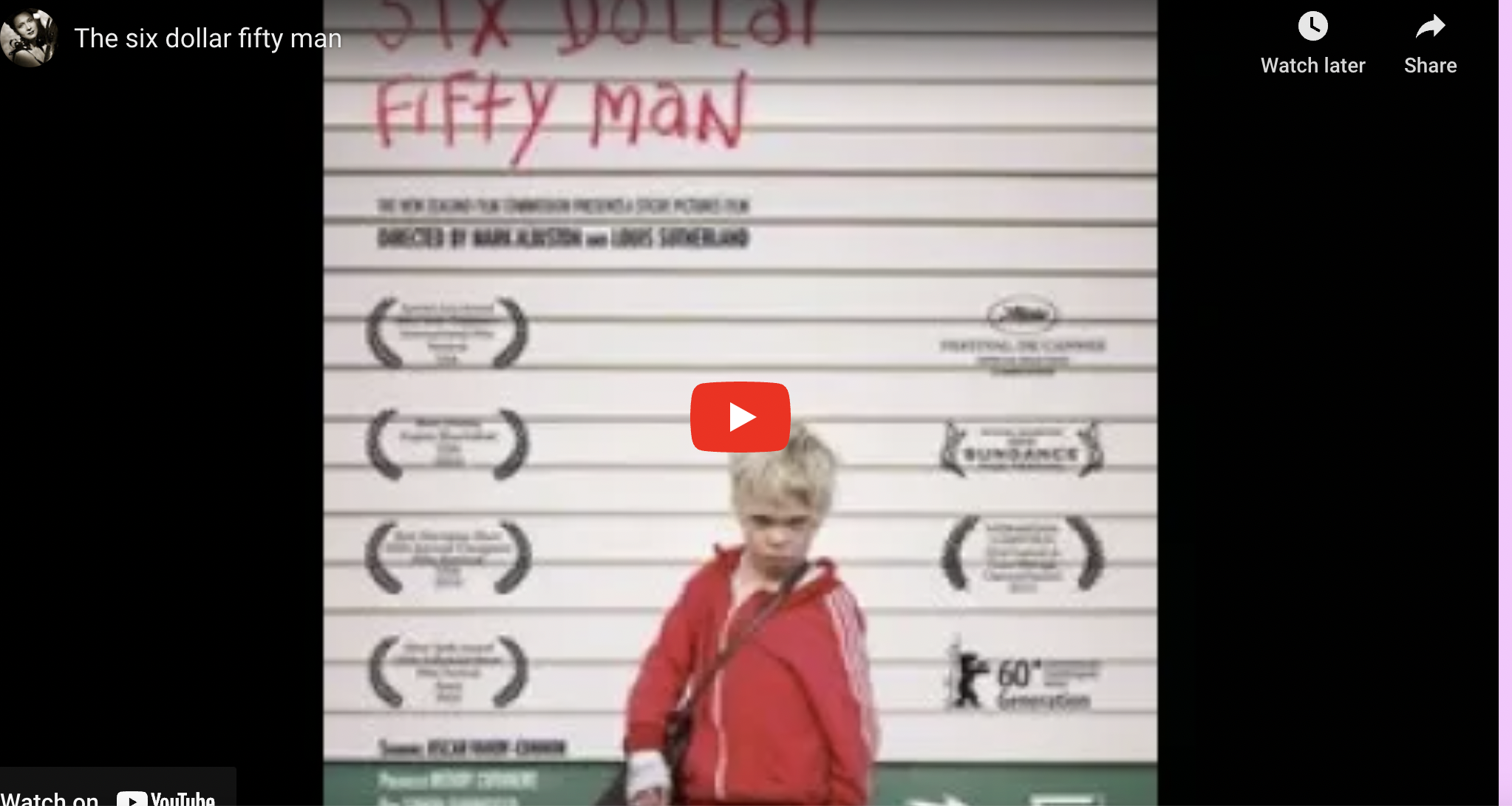
-
PLAN & DO / WHAKAMAHI learning intentions:
- We are PLANNING our writing so that we can use the TEXAS paragraph structure in essay writing.
I am an active learner as I know what I need to learn, where I am with that learning and what my next learning steps are:
- Emerging:
- I know what I am learning and why
- I can use evidence to identify where I am with my learning
- I can use evidence to identify my next learning steps
- Growing:
- I can describe what I am learning and why, using our shared language for learning; GREAT Ako
- I can use evidence to describe where I am with my learning
- I can use evidence to plan and take my next learning steps
MHJC Great Learner Learning to Learn / Ako: Learning and Thinking Strategy

Kia ora Year 9C2
In session 1 on Monday, we will be sitting for our Reading E-asttle.
In Session 2- we have a library lesson booked.
In Session 3 we will be revising some of our writing and language skills to be well prepared for our upcoming CATs.
Learning Intentions:
- Students will be able to write a clear and concise essay that supports their argument with evidence.
- Students will be able to use appropriate language and style for an academic essay.
- The essay will have a clear and concise thesis statement that states the main argument.
- The essay will provide evidence from at least three sources to support the thesis statement.
- The essay will be well-organised and easy to follow.
- The essay will use academic language and style.
- The essay will use the TEXAS paragraph structure.
Writing Prompts for Year 9 Students on the Theme of People's Choices and the Environment
Prompt 1:
You are a scientist who has discovered a new way to produce energy that is completely clean and renewable. However, this new technology is very expensive to develop and implement. Write a letter to the government explaining why they should invest in this new technology, and how it will benefit people and the environment in the long term.
Prompt 2:
You are a journalist who has been assigned to write an article about the environmental impact of the fashion industry. Research the fashion industry and its impact on the environment, and write an article that informs the public about this issue.
Prompt 3:
You are a student leader who is organising a campaign to reduce plastic waste in your school. Write a speech that you will give to your classmates about the importance of reducing plastic waste, and how they can make a difference.
Prompt 4:
You are a writer who has been commissioned to write a short story about the impact of people's choices on the environment. Choose one or more of the following choices and write a story about how it impacts people and the environment:
- What you eat
- What you wear
- How you get around
- How you spend your money
- How you use energy
Bonus Prompt:
You are a time traveler who has been sent back in time to the year 2023. You know that the Earth is facing a climate crisis, and you want to warn people about the dangers of climate change. Write a speech that you will give to the people of 2023, explaining the causes and consequences of climate change, and what they can do to prevent it.
- We are PLANNING our writing so that we can use the TEXAS paragraph structure in essay writing.
-
Common Assessment Task Week
-
EXPLORE / TŪHURA learning intentions:
- We are EXPLORING the visual language features in a short film.
- We are OBSERVING the camera angles and visual techniques used.
- We are ANALYSING two short films and developing our abilities to compare and contrast these films.
MHJC GREAT Learner Learning to Learn / Ako: Digital Literacy

MHJC Great Learner Learning to Learn / Ako: Learning and Thinking Strategy

Success Criteria for Comparing and Contrasting Two Short Films
-
Identify key themes and messages: Clearly identify the central themes and messages conveyed in each film.
-
Analyze narrative structures and stylistic choices: Compare and contrast the narrative structures and stylistic choices employed in each film, explaining how they contribute to the overall impact.
-
Highlight similarities and differences: Identify and discuss the similarities and differences between the films, considering their plots, characters, and overall themes.
-
Support claims with evidence: Provide evidence from both films to support the claims made in the comparison and contrast.
-
Formulate a personal opinion: Express a personal opinion on the films, indicating which one resonates more strongly and why.
Learning Intentions for Comparing and Contrasting Two Short Films
-
Develop critical viewing skills: Analyze and evaluate short films based on their narrative structures, stylistic choices, and themes.
-
Enhance comparative writing skills: Effectively compare and contrast two short films, highlighting similarities and differences while supporting claims with evidence.
-
Foster a deeper understanding of film genres: Gain a broader understanding of the characteristics and conventions of different film genres, such as satire and psychological thrillers.
-
Appreciate the impact of cinematic techniques: Recognize and appreciate the impact of various cinematic techniques, such as cinematography, editing, and sound design, in shaping the overall viewing experience.
-
Develop personal preferences in filmmaking: Formulate personal preferences in filmmaking, identifying aspects that resonate with personal tastes and interests.
Exemplar Movie Review: Parasite and The Handmaiden
Introduction
Parasite (2019) and The Handmaiden (2016), both directed by Bong Joon-ho, are South Korean films that have garnered critical acclaim and international recognition. While both films are steeped in Korean culture and explore themes of class and social inequality, they differ in their narrative approaches and stylistic choices, offering audiences unique cinematic experiences.
Parasite: A Satirical Social Commentary
Parasite unveils the stark contrast between the wealthy Kim family, living in a luxurious modern home, and the impoverished Park family, occupying a cramped basement apartment. The Kims, driven by desperation and cunning, infiltrate the Parks' lives, securing employment and exploiting their naivety. Through its darkly comedic and suspenseful plot, Parasite exposes the deep-rooted societal divisions and the lengths to which individuals will go to achieve financial stability.
The Handmaiden: A Gothic Psychological Thriller
The Handmaiden delves into a world of intrigue and deception, set in Japanese-occupied Korea during the 1930s. Sook-hee, a young woman raised in a harsh orphanage, is hired as a handmaiden to Lady Hideko, a mysterious and reclusive noblewoman. However, Sook-hee is soon drawn into a plot orchestrated by a cunning conman, Count Fujiwara, who seeks to marry Lady Hideko for her wealth. The film's intricate plot, coupled with its gothic atmosphere and psychological elements, explores themes of desire, manipulation, and the blurred lines between reality and illusion.
Contrasting Narrative Approaches
Parasite and The Handmaiden employ distinct narrative techniques to convey their intended messages. Parasite utilizes a linear narrative, seamlessly intertwining the lives of the Kims and Parks, highlighting the parallels and contradictions between their worlds. In contrast, The Handmaiden adopts a nonlinear structure, employing multiple perspectives and flashbacks, unraveling the complex web of relationships and motivations.
Stylistic Choices and Cinematic Impact
Bong Joon-ho's masterful direction and the films' striking cinematography contribute significantly to their impact. Parasite's use of contrasting visual elements, such as the Kims' cramped basement apartment juxtaposed against the Parks' expansive mansion, effectively underscores the stark social divide. The Handmaiden's meticulously crafted settings, infused with a sense of isolation and foreboding, enhance the film's psychological tension.
Conclusion: Two Masterful Cinematic Works
Parasite and The Handmaiden, though distinct in their narrative approaches and stylistic choices, stand as powerful examples of Bong Joon-ho's cinematic brilliance. Both films offer thought-provoking explorations of societal issues, captivating audiences with their intricate plots, memorable characters, and masterful filmmaking techniques
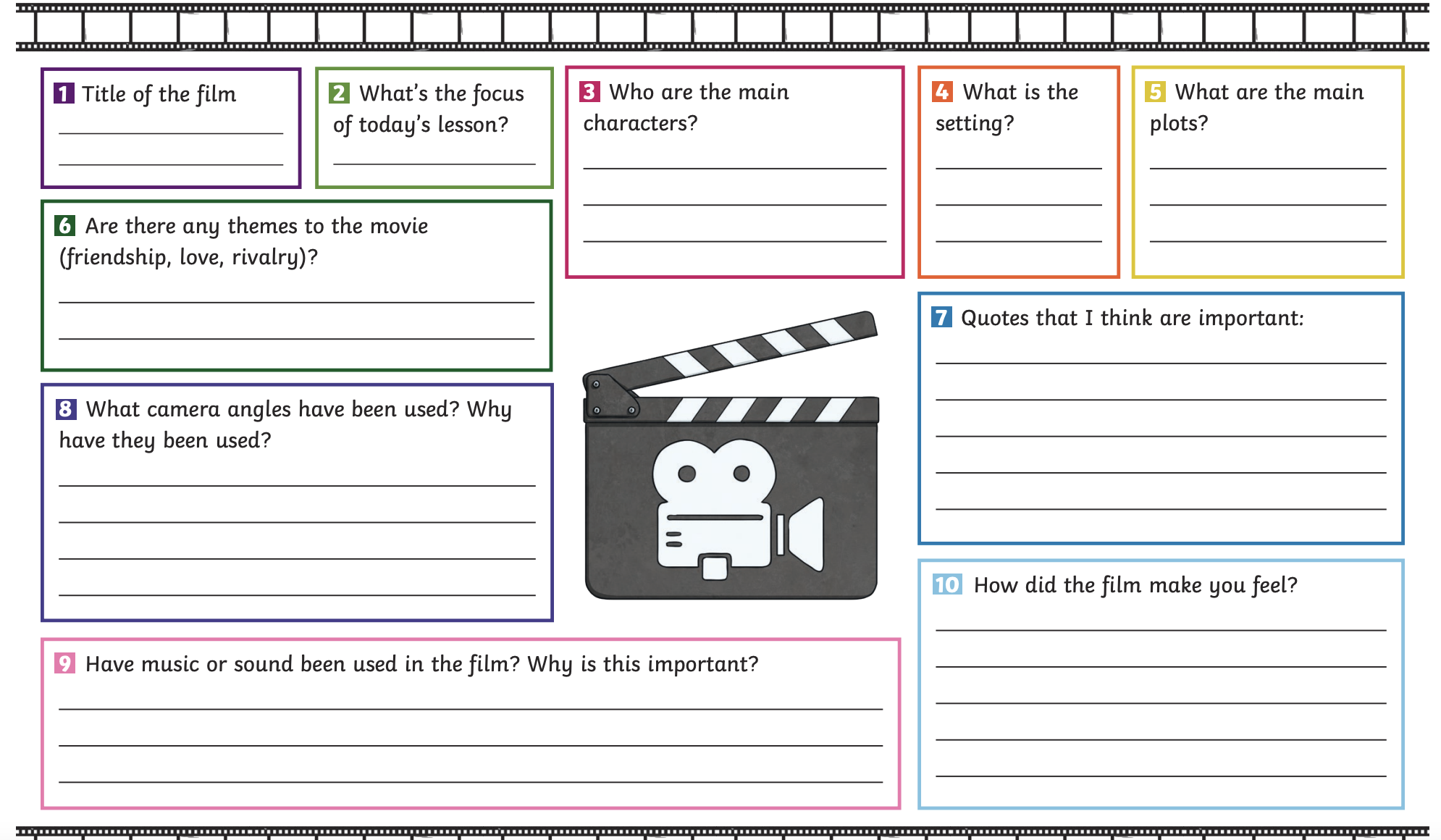
-
EXPLORE / TŪHURA learning intentions:
- We are EXPLORING the visual language features in a short film.
- We are OBSERVING the camera angles and visual techniques used.
- We are ANALYSING two short films and developing our abilities to compare and contrast these films.
MHJC GREAT Learner Learning to Learn / Ako: Digital Literacy

MHJC Great Learner Learning to Learn / Ako: Learning and Thinking Strategy

Success Criteria for Comparing and Contrasting Two Short Films
-
Identify key themes and messages: Clearly identify the central themes and messages conveyed in each film.
-
Analyze narrative structures and stylistic choices: Compare and contrast the narrative structures and stylistic choices employed in each film, explaining how they contribute to the overall impact.
-
Highlight similarities and differences: Identify and discuss the similarities and differences between the films, considering their plots, characters, and overall themes.
-
Support claims with evidence: Provide evidence from both films to support the claims made in the comparison and contrast.
-
Formulate a personal opinion: Express a personal opinion on the films, indicating which one resonates more strongly and why.
Learning Intentions for Comparing and Contrasting Two Short Films
-
Develop critical viewing skills: Analyze and evaluate short films based on their narrative structures, stylistic choices, and themes.
-
Enhance comparative writing skills: Effectively compare and contrast two short films, highlighting similarities and differences while supporting claims with evidence.
-
Foster a deeper understanding of film genres: Gain a broader understanding of the characteristics and conventions of different film genres, such as satire and psychological thrillers.
-
Appreciate the impact of cinematic techniques: Recognize and appreciate the impact of various cinematic techniques, such as cinematography, editing, and sound design, in shaping the overall viewing experience.
-
Develop personal preferences in filmmaking: Formulate personal preferences in filmmaking, identifying aspects that resonate with personal tastes and interests.
Exemplar Movie Review: Parasite and The Handmaiden
Introduction
Parasite (2019) and The Handmaiden (2016), both directed by Bong Joon-ho, are South Korean films that have garnered critical acclaim and international recognition. While both films are steeped in Korean culture and explore themes of class and social inequality, they differ in their narrative approaches and stylistic choices, offering audiences unique cinematic experiences.
Parasite: A Satirical Social Commentary
Parasite unveils the stark contrast between the wealthy Kim family, living in a luxurious modern home, and the impoverished Park family, occupying a cramped basement apartment. The Kims, driven by desperation and cunning, infiltrate the Parks' lives, securing employment and exploiting their naivety. Through its darkly comedic and suspenseful plot, Parasite exposes the deep-rooted societal divisions and the lengths to which individuals will go to achieve financial stability.
The Handmaiden: A Gothic Psychological Thriller
The Handmaiden delves into a world of intrigue and deception, set in Japanese-occupied Korea during the 1930s. Sook-hee, a young woman raised in a harsh orphanage, is hired as a handmaiden to Lady Hideko, a mysterious and reclusive noblewoman. However, Sook-hee is soon drawn into a plot orchestrated by a cunning conman, Count Fujiwara, who seeks to marry Lady Hideko for her wealth. The film's intricate plot, coupled with its gothic atmosphere and psychological elements, explores themes of desire, manipulation, and the blurred lines between reality and illusion.
Contrasting Narrative Approaches
Parasite and The Handmaiden employ distinct narrative techniques to convey their intended messages. Parasite utilizes a linear narrative, seamlessly intertwining the lives of the Kims and Parks, highlighting the parallels and contradictions between their worlds. In contrast, The Handmaiden adopts a nonlinear structure, employing multiple perspectives and flashbacks, unraveling the complex web of relationships and motivations.
Stylistic Choices and Cinematic Impact
Bong Joon-ho's masterful direction and the films' striking cinematography contribute significantly to their impact. Parasite's use of contrasting visual elements, such as the Kims' cramped basement apartment juxtaposed against the Parks' expansive mansion, effectively underscores the stark social divide. The Handmaiden's meticulously crafted settings, infused with a sense of isolation and foreboding, enhance the film's psychological tension.
Conclusion: Two Masterful Cinematic Works
Parasite and The Handmaiden, though distinct in their narrative approaches and stylistic choices, stand as powerful examples of Bong Joon-ho's cinematic brilliance. Both films offer thought-provoking explorations of societal issues, captivating audiences with their intricate plots, memorable characters, and masterful filmmaking techniques

-
Kia ora Year 9's
This week we will be focusing on our Film Study- Hunt for the Wilderpeople.
Learning intentions
- Think critically to identify and describe the key aspects of a visual text.
- Develop self direction, responsibility, initiative, cooperation, adaptability, and accountability while working with others.
- Develop creativity and innovation skills by creating an original and engaging presentation.
Demonstrate knowledge of the key aspects of a visual text by creating and producing an engaging presentation.
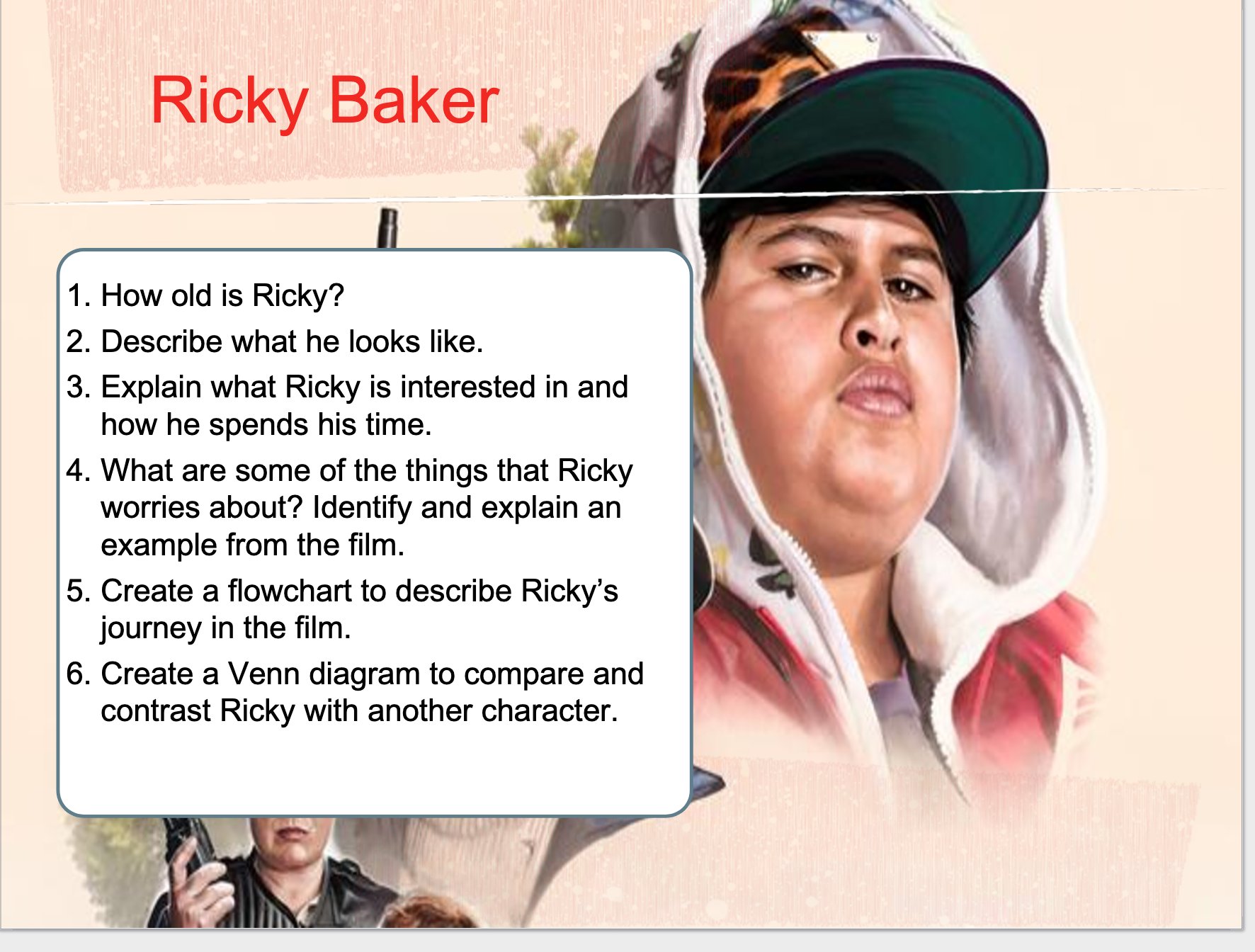
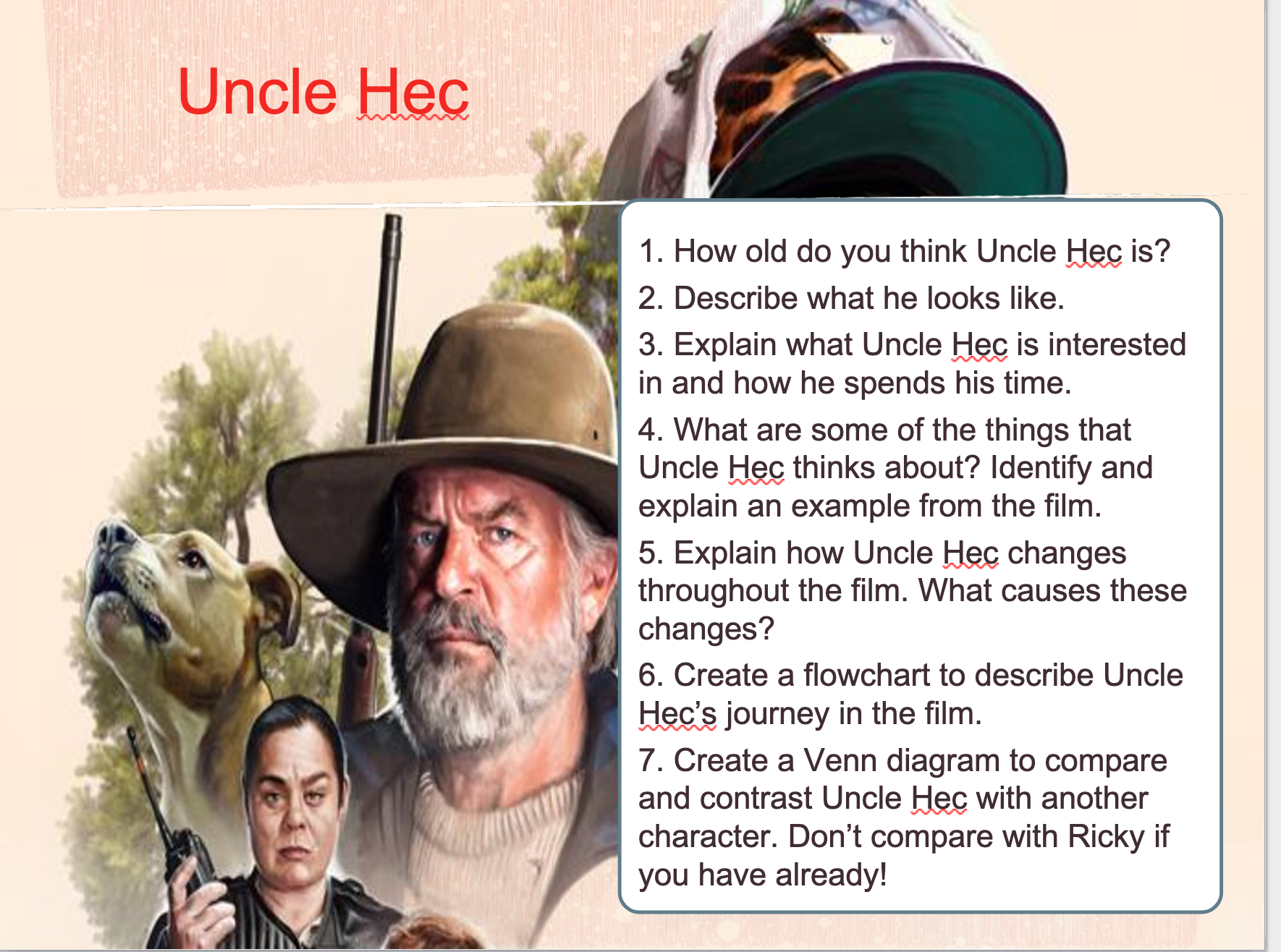

-
Kia ora Year 9's
This week we will be focusing on our Film Study- Hunt for the Wilderpeople.
Learning intentions
- Think critically to identify and describe the key aspects of a visual text.
- Develop self direction, responsibility, initiative, cooperation, adaptability, and accountability while working with others.
- Develop creativity and innovation skills by creating an original and engaging presentation.
-
Demonstrate knowledge of the key aspects of a visual text by creating and producing an engaging presentation.
